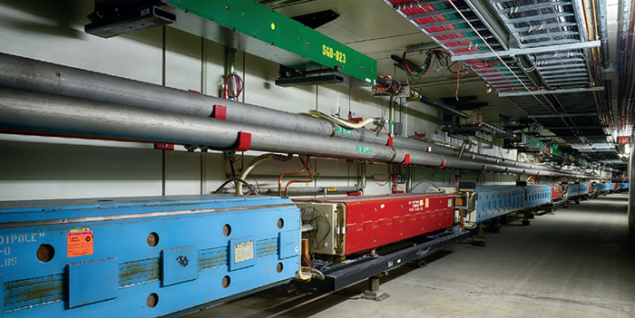
Image credit: Fermilab.
In June, Fermilab’s Main Injector accelerator sustained a 521 kW proton beam, and set a world record for the production of high-energy neutrinos with a proton accelerator. The 120 GeV proton beam is used to provide high-energy neutrinos or antineutrinos to three experiments at the laboratory: the long-baseline experiments MINOS+ and NOvA (CERN Courier June 2015 p17) and the neutrino-interaction experiment MINERvA (CERN Courier April 2014 p26).
The record beam surpasses that of the proton beam of more than 400 kW achieved at CERN for the CERN Neutrinos to Gran Sasso (CNGS) beamline, which provided neutrinos for the ICARUS and OPERA long-baseline experiments. The highest beam powers for fixed-target proton beams are achieved with protons in the giga-electron-volt range. Both the Spallation Neutron Source at Oak Ridge National Laboratory and the cyclotron facility at the Paul Scherrer Institute in Switzerland create proton beams with powers in excess of 1 MW. In the 1990s, Los Alamos National Laboratory operated a 0.8 GeV proton beam at about 800 kW for its low-energy neutrino experiment, LSND.
The power of the proton beam is a key element in producing neutrinos at accelerators: the more protons packed in the beam, the higher the number of neutrinos and antineutrinos produced and the better the chance to record neutrino interactions. The protons strike a target to create pions and other short-lived particles; the higher the proton energy, the larger the number of pions produced. Magnetic-focusing horns direct the charged pions into a vacuum pipe that is centred along the desired neutrino-beam direction. As the pions decay, they produce neutrinos and antineutrinos that are boosted in the direction of the original pions.
Since 2011, Fermilab has made significant upgrades to its accelerators and reconfigured the complex to provide the best possible particle beams for neutrino and muon experiments. The next goal for the 3.3 km circumference Main Injector accelerator is to deliver 700 kW in 2016 – double the beam power produced in the Tevatron era.
Fermilab plans to make additional upgrades to its accelerator complex over the next decade. The Proton Improvement Project-II includes the construction of a 800 MeV superconducting linac. Its beam would enable the Main Injector to provide more than 1.2 MW of proton beam power for the international Deep Underground Neutrino Experiment (CERN Courier April 2015 p20).
Fermilab also operates a second neutrino beamline, powered by its 8 GeV booster accelerator. This provides neutrinos for the Short Baseline Neutrino programme, which comprises three neutrino detectors: MicroBooNE (construction complete), ICARUS (upgrades underway at CERN) and the Short Baseline Neutrino Detector (construction to start in 2016).





